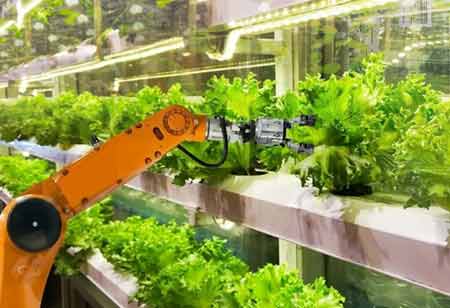Thank you for Subscribing to Agri Business Review Weekly Brief
Why are Farmers Moving towards Vertical Farming?
A new generation of farmers is responding to the challenge of sustainability.

By
Agri Business Review | Thursday, September 16, 2021
Stay ahead of the industry with exclusive feature stories on the top companies, expert insights and the latest news delivered straight to your inbox. Subscribe today.
Although vertical farms will not completely replace traditional farming methods, they have the potential to reimagine agriculture's future by promoting a more sustainable, economically reasonable, and health-conscious world.
Fremont, CA: A new generation of farmers is responding to the challenge of sustainability. This agricultural revolution is characterized by a shift away from traditional farming toward future high-tech artificial intelligence (AI) and robotics. The farming landscape is changing, whether it's through the use of weed-killing robots, harvesting and picking robots, or autonomous tractors. Producers believe that combining automation and data will enable farmers to produce more while causing less environmental damage. Vertical farming is one significant process change that is currently gaining traction.
Vertical farming is not a new invention. However, recent supply chain disruptions, combined with the lowering price of produce, are creating new opportunities for a farming approach that many previously considered unviable.
Why are farmers moving towards vertical farming?
Vertical farming is the method of growing food in stacked layers vertically. The climate-controlled indoor farms have rows of plants growing vertically and suspended from the ceiling. Robotics assist in maneuvering the items, and AI can monitor the various parameters essential for crops to flourish, such as water, temperature, and light levels.
The objective is to advance vertical farming by building intelligent robots that can boost precision and productivity while reducing environmental impact and danger. Agriculture, one of humanity's first discoveries, is integrating with cutting-edge technology, and farmers will soon be seeking a dependable automation components supplier to help them make the transition to vertical farming.
Vertical farming has a number of distinct advantages. Farmers recognize that there are numerous compelling and practical reasons to expand upward rather than outward. This agricultural practice has enormous potential for ensuring food security and sustainability while also conserving the environment, economy, and ecosystems. Additionally, the incorporation of AI and robotics guarantees year-round, high-quality product growth while preserving 95 percent of water, fertilizers, and land consumption. Indoor farming, when done correctly and with the assistance of AI and robots, also protects crops from pest incursions and ensures they are adequately insulated.
Vertical farms are not geographically restricted and are not susceptible to the constraints associated with outside farming, such as adverse weather conditions. This safeguards not only the crops but also creates a safer work environment for laborers. Additionally, vertical farming can significantly cut energy use by utilizing LED lighting that mimics the sun as a light source. A small adjustment such as this can help reduce heat loss while enhancing energy efficiency and lowering energy expenses.





